
Location:
Fingal Head Light is an active lighthouse located at Fingal Head on the southern side of the Tweed river about 5 kilometres south of the Point Danger light which is on the opposite side of the river mouth and which marks the NSW and Queensland border.
Summary:
GPS: Lat: 28° 12’ S : Long: 153° 34’ E
First Lit: 1879 (Automated 1920)
Tower height: 7 m, Elevation 24 m
Original Lens: 4th Order Chance Bros. fixed
Range: White 17 nml; Red 14 nml
Current Characteristic: A White and Red flash every 5 seconds [Fl W.R. 5s]
History:
Indigenous:
The Bundjalung people are the traditional custodians of this area. The headland, known as “Booninybah,” holds significant cultural importance and means the place of the echidna. The unusual basalt rock columns are said to be the remains of a giant echidna which features in the creation story of the Tweed River. The many shell middens and other remnants of habitation suggest the area had supported a thriving indigenous population over many thousands of years prior to european colonisation.
Colonial:
Captain James Cook named Point Danger on 16th May, 1770 but there has been conjecture over whether the point that Captain Cook described in his journal as being Point Danger is actually Fingal Head but the geographical place names board have now agreed that Point Danger will remain the name of it’s current location.
The 1860s saw an increase in shipping trade with the new colony of Queensland. Three reefs running out almost 7km from Fingal Head and Cook Island itself were a constant danger as there is deep water close to shore. The growing maritime traffic and dangerous coastal conditions necessitated the construction of a lighthouse.


Even though the Fingal Head light tower is not high and it is built on a low headland the lighthouse is effective as it is built on one of the most easterly points of Australia. It is however obscured by Cook Island. It was recommended in the 1912 Brewis Report into Coastal lights that Fingal Head be discontinued and a light on Cook Island be established. This recommendation was not followed and the light remains active. It was not until 1971 that a light was established on Point Danger to complement the Final Head light.
The Structure:
Fingal Head Lighthouse is one of the oldest lighthouses on the NSW coast. Built in 1872, it represents early colonial maritime infrastructure development.
A basic light station consisting of a kerosene light atop a 9m wooden pole was first established in February 1872. The keeper had to row from the Tweed Heads Pilot Station each day and light the lantern at sunset until 1875 when a hut was constructed for him to stay in.
In October 1878 the Maritime Board of New South Wales decided to construct a modern lighthouse at the location. It was the third of five lighthouses of similar design designed by James Barnet in 1878–80, the other four being Richmond River Light, Clarence River Light, Tacking Point Lighthouse and Crowdy Head Light. I


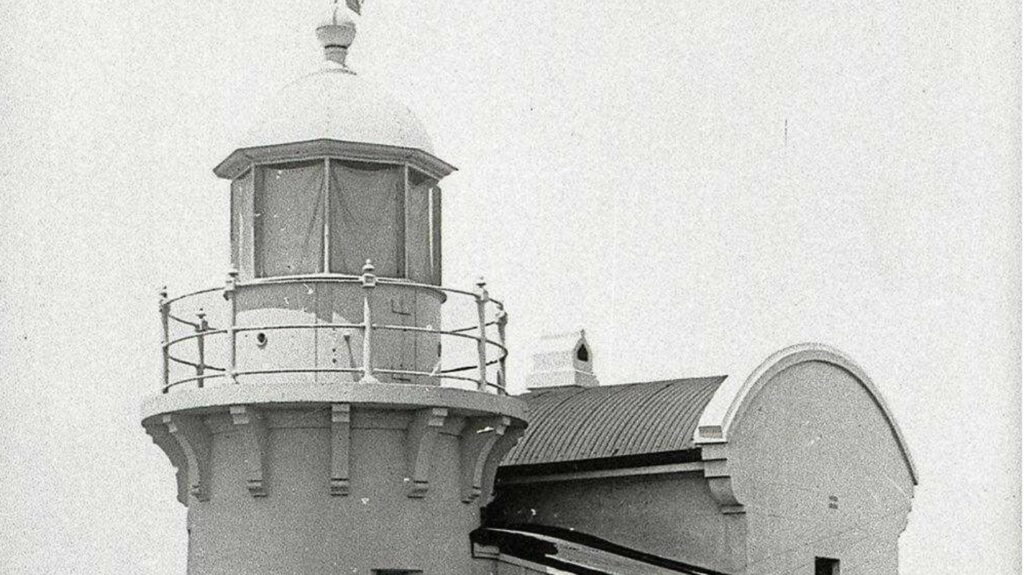
The Tower: Fingal Head Lighthouse is a small but robustly constructed tower, built to Colonial Architect James Barnet’s design specifications. Standing just 7 meters tall, its design capitalizes on the natural height of the headland to achieve its effective focal height of 24 meters above sea level. The tower is constructed of locally sourced clay bricks, rendered with cement and painted white – a signature characteristic of Australian lighthouses.
The lighthouse exhibits Classical Revival architectural elements typical of Barnet’s work, though on a smaller scale than his other lighthouses. The tower features a smooth cylindrical shaft rising from a broader base course. The design includes a curved gallery platform encircling the lantern room, supported by corbel brackets. The lantern room is topped with a domed copper roof and ventilator.
Internal Features: The internal structure includes a cast iron spiral staircase leading to the lantern room. The walls taper slightly from base to top, maintaining the structural integrity while reducing weight. The interior walls were originally painted with oil-based paint to protect against moisture.
Lantern Room: The lantern room houses the original third-order dioptric lens system. The optical apparatus is enclosed by curved glass panes set in a copper-clad frame with ventilation ports to prevent condensation. The original kerosene lamp was positioned at the focal point of the lens system.


The lighthouse and keeper’s cottage were constructed by Joseph William Mortley and Shepherd who were successful with their government tender. The present lighthouse was completed in 1879 and handed over to Lightkeeper William Arnold on 30 March 1879. The light tower is the oldest public building in the Tweed Shire.
The lighthouse is constructed of brick and cement render, painted white. Unlike many of its contemporaries, it was built on a smaller scale due to the height of the headland itself.
Technical Details:
The first apparatus was a Chance Bros 4th order Catadioptric fixed lens illuminanted by a two wick burner producing 1,000 candelas giving a range of 12 nautical miles. The light was converted to automatic acetylene operation in 1923 with an output of 1,500 candelas and altered to group flashing. The one keeper was withdrawn at this time.

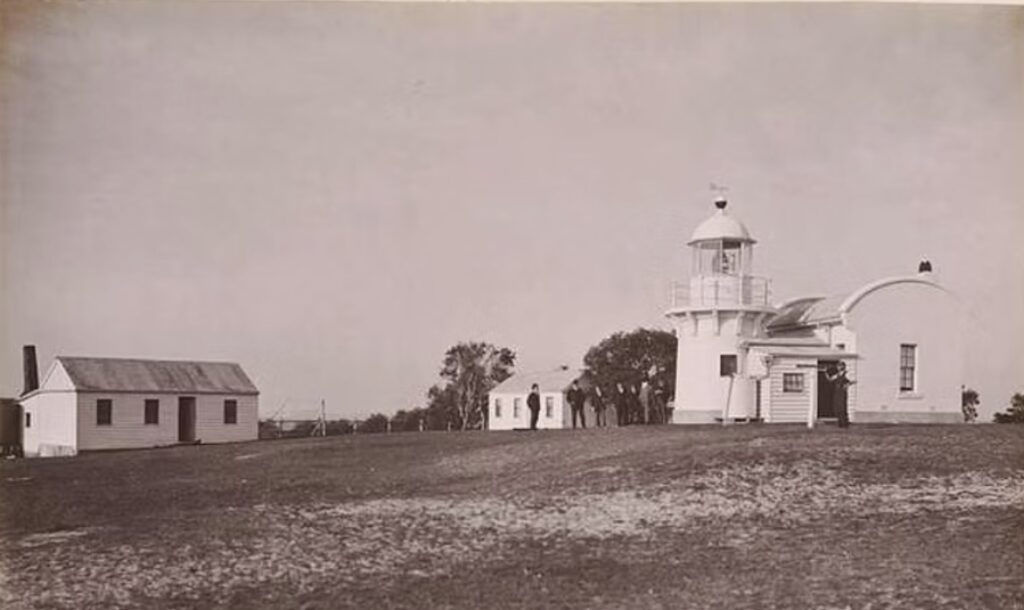
On 15 June 1920 the light was converted to an automatic carbide lamp (acetylene gas) apparatus, with an intensity of 1,500 cd, and altered to group flashing. Soon after, the station was demanned and all buildings other than the tower were demolished.
In 1980 the light was converted to electricity. The current light source is a modern FA-251 Beacon with a 12 Volt 75 Watt HL-2000 quartz halogen lamp. It is fed by mains electricity with a battery standby. It revolves once every 30 seconds
In 1970 the light was converted to mains electricity. Fingal Head was converted to an LED light source in early 2021 with the installation of a fixed high intensity LED beacon.
The current light characteristic is a flash every five seconds, red to east and white to other directions (Fl.W.R. 5s). The light retains a red sector to warn of the off shore dangers around Cook Island.
Interesting Facts:
Fingal Head Lighthouse stands as one of the smallest lighthouses on the NSW coast, yet its significance extends far beyond its modest size. Named after the legendary Irish giant Fingal, which is derived from what the the headland is characterized by its remarkable hexagonal basalt rock formations that mirror those of the Giant’s Causeway in Northern Ireland. The lighthouse’s design was unique for its time, operating with a single keeper rather than the traditional three-keeper system employed at most other stations.
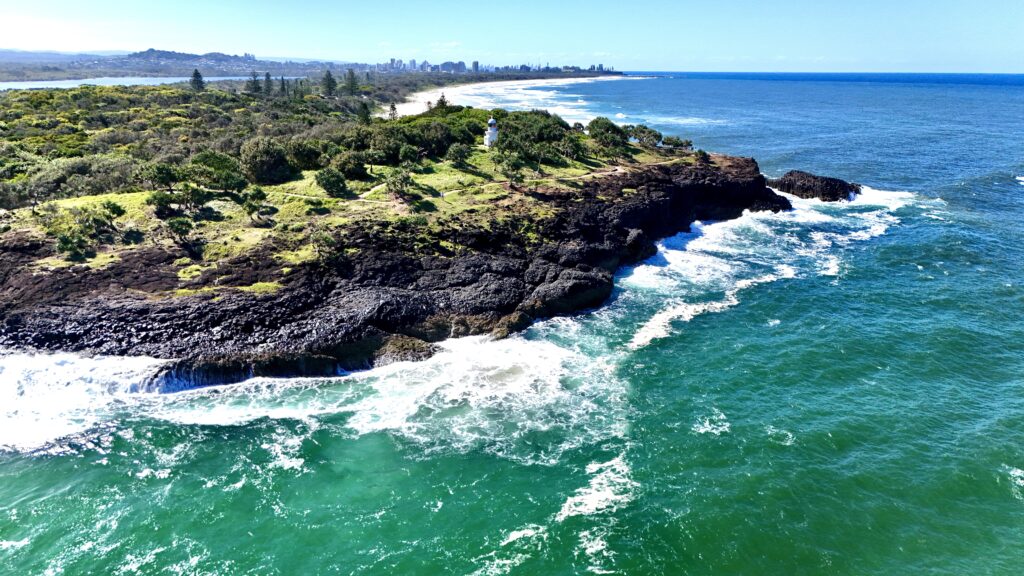
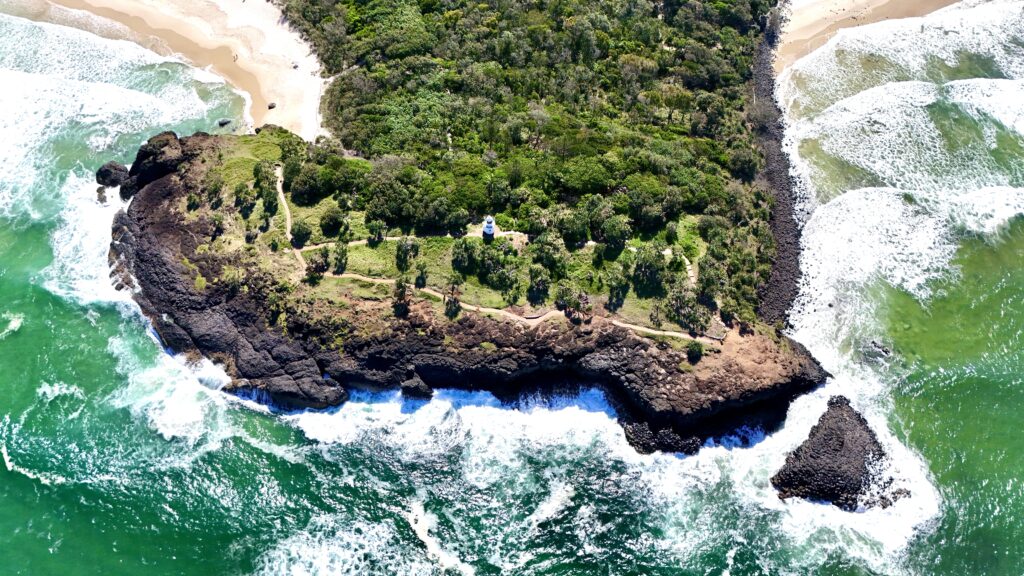
The original keeper’s cottage, which stood until the 1920s, has since been demolished, though the lighthouse itself retains much of its original architectural features. The site has evolved into a significant whale watching location, where observers can witness the annual migration along the coast. Beyond its role as a navigational aid, particularly for vessels entering the Gold Coast seaway, the lighthouse has played a crucial role in the development of the Tweed region. Its position has made it an important location for monitoring coastal weather patterns, contributing valuable meteorological data over its long service history.
Keepers of the Light:
The history of Fingal Head’s keepers is unique among Australian lighthouses. Unlike most stations that required multiple keepers, Fingal Head operated with a single keeper from its establishment in 1872. This solitary position created a particular kind of lighthouse keeping experience, where self-reliance and independence were essential qualities. The first keeper established the foundation for what would become a tradition of dedicated service at this isolated post.


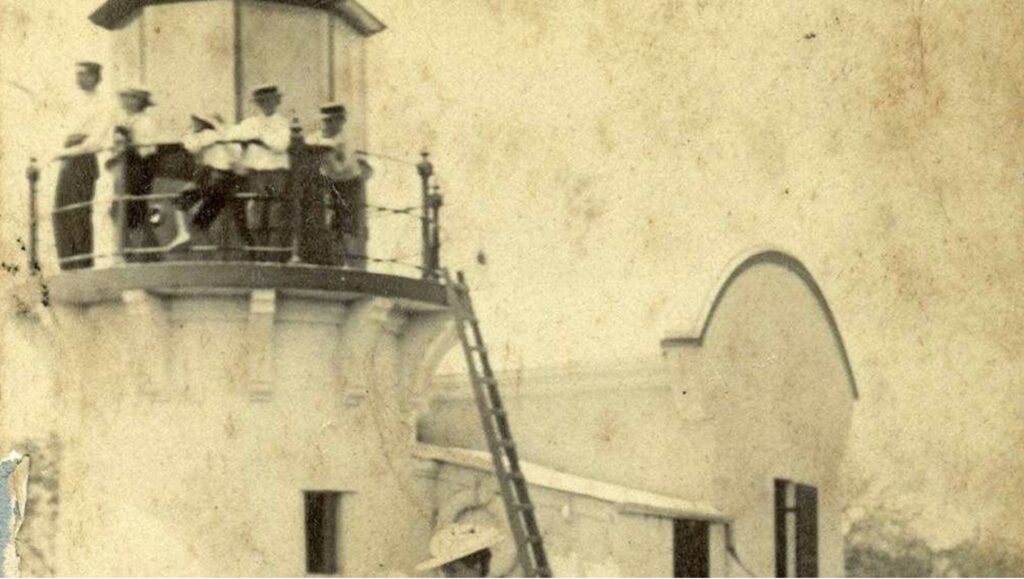
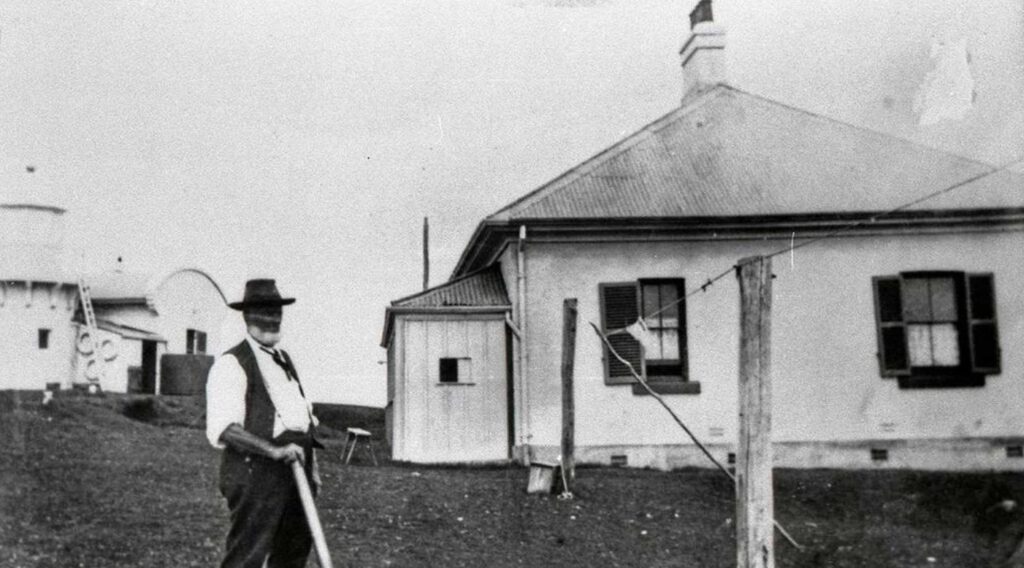
Though individual keeper records are less extensive than at larger stations, local families played significant roles in maintaining the lighthouse during its early years, creating a strong connection between the lighthouse and the developing Tweed community. This system of single keeper operation continued until 1920 when the full time keepers role was replaced with a care and maintenance contract with local tradesmen who had responsibility for a number of lighthouses in the region. The lighthouse was fully automated in 1994.
The lighthouse keeper’s residence was built in 1879 and demolished in 1923 when the light was automated. The foundations are visible nearby the lighthouse. William Arnold, the first lighthouse keeper, his wife Henrietta and 11 children lived here for 27 years until 1st September 1906 when he retired. Arnold was followed by Francis Brady 1906-1910, Charles Leverton 1910-1919 and Charles Thompson 1919-1920 (1923?)
Shipwrecks & Tragedies:
The waters surrounding Fingal Head have witnessed numerous maritime dramas over the centuries, with the treacherous currents and rocky coastline claiming several vessels even before the lighthouse’s construction. One of the most notable early incidents was the loss of the schooner ‘Ebenezer’ in 1859, which highlighted the urgent need for a lighthouse at this dangerous point along the coast. The vessel’s demise, along with other maritime losses, contributed to the eventual decision to establish a lighthouse at Fingal Head.
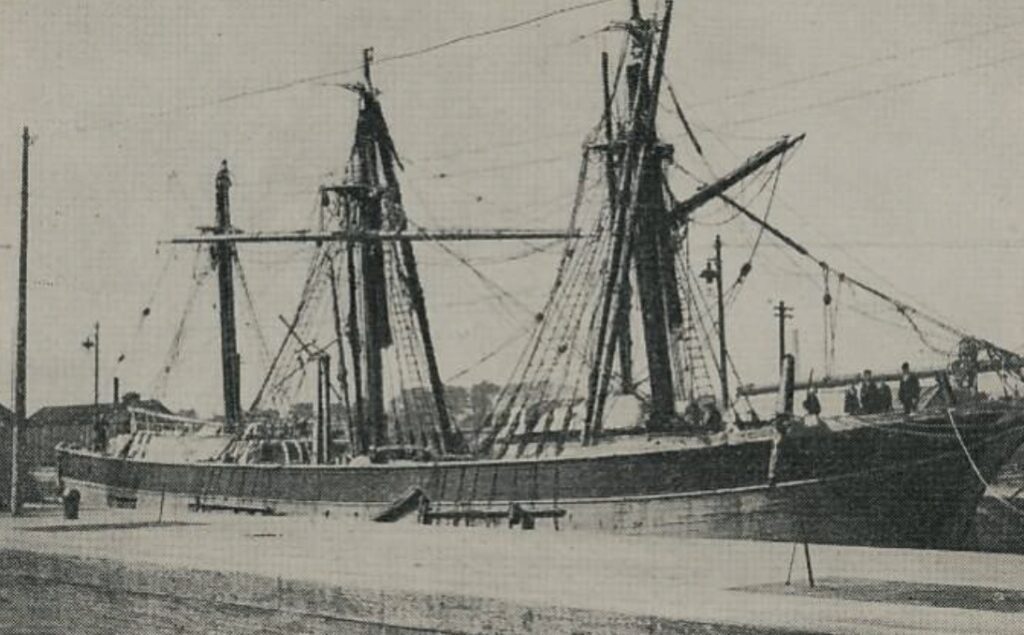

The waters around Cook Island, visible from the lighthouse, have proven particularly hazardous throughout history. The complex interaction of ocean currents around the island and headland has created challenging conditions that have claimed several fishing vessels over the years. These waters continue to demand respect from modern seafarers, with local fishing boats and recreational vessels occasionally finding themselves in difficulty despite the lighthouse’s warning beacon.
Throughout its history, the headland has been the site of numerous rescue operations, with lighthouse keepers often playing crucial roles in coordinating assistance to vessels in distress. The dangerous currents that sweep around the headland have also claimed lives closer to shore, particularly as the area became popular with swimmers and surfers. In response to these incidents, additional safety measures have been implemented over the years, though the powerful ocean forces around Fingal Head continue to command respect from all who venture near its waters.
The legacy of these maritime incidents lives on in the local community’s respect for the ocean’s power, and the lighthouse stands as a testament to the ongoing need for maritime safety in these waters. Modern-day incidents, particularly those involving surfing accidents near the headland, serve as reminders that despite technological advances in maritime safety, the ocean around Fingal Head remains as challenging as it was when the first lighthouse keeper took up their post in 1872. CopyRetry
Myths & Mysteries:
The rich tapestry of stories surrounding Fingal Head is deeply rooted in Indigenous culture. According to Bundjalung legend, the giant echidna Booninybah was a central figure in the creation story of the Tweed River. The distinctive basalt columns that characterize the headland are said to be the petrified remains of his ancestors, forever standing guard over the coastline.

Cook Island, visible from the lighthouse, has been the source of numerous reports of mysterious lights over the years, puzzling both keepers and local residents. The basalt formations themselves are steeped in local folklore, with stories of spirits dwelling within the columnar structures. During storms, visitors and keepers have reported unexplained sounds echoing through the headland, which some attribute to the ancient spirits of the place. Local legends also tell of smugglers who once utilized the caves beneath the headland, though these tales remain unverified. Perhaps most intriguingly, there are accounts of ghost ships seen during full moons, reminiscent of the many vessels that challenged these waters in earlier times.
Current Status:
Fingal Head Lighthouse remains an active aid to navigation, managed by the Australian Maritime Safety Authority (AMSA). The custodian is the NSW Department of Crown Lands and the operation is the responsibility of the Transport NSW which includes Maritime Services. The site is open to the public but the tower is not.
Nice informative post Mike.
Another good one Mike! I reckon Chance Brothers is a great name for a band!
Thanks Rob, I’ll make sure I come and see the Chance Bros next time they are playing! I’m around Sydney until mid-February and would like to take you to a lunch or dinner when your available. Not a date I might add but a chance to say thanks and have a chat which is probably about 50 years overdue! All the best for Christmas and the NY!!!